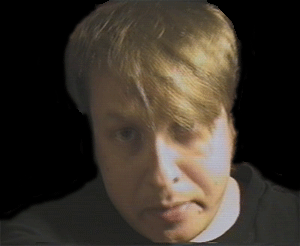
A treat for electronic ambient fans is provided by a long-awaited CD re-release of Esa Kotilainen's Tangerine Dream/Klaus Schulze-style solo album Ajatuslapsi ("A Thought Child") from 1977, which is now out on Love/Siboney, a company specializing in CD re-releases of the legendary Finnish label Love Records, which went bankrupt in 1979, leaving behind a large legacy in Finnnish rock, jazz, folk and also political music.
The album was originally released as an edition of 500 copies, Kotilainen playing all instruments there. Alongside Tangerine Dream, Lobsang Rampa's controversial book The Third Eye is mentioned as its inspiration, Kotilainen visualising such tracks as 'Avartuva näkemys' as a journey of Tibetan monks in a cave of stalactites.
Esa Kotilainen in 1979, introducing the electronic sounds of Moog
Esa Kotilainen (b. 1946) is known as a keyboard wizard and synth veteran, who provided his contributions to Wigwam's most popular album Nuclear Nightclub (1975), also as a member of the band's latest incarnation, which is still in business. Furthermore, Kotilainen has provided his services as a session musician for such as Tasavallan Presidentti, Jukka Tolonen, Hector, J. Karjalainen, Nils-Aslak Valkeapää and many more. He has also been a member of Neum.
Esa Kotilainen's career in electronic music started in 1974 when he expensively imported from Germany a MiniMoog, an instrument rarely seen in Finland those days. During this era Kotilainen was playing gigs on a ferry called Finnhansa, which sailed between Helsinki and Travemünde, and paid for the instrument 6.100 Finnish marks: the price of a small car those days. The first gig with Kotilainen's Minimoog was creating sound effects for the soundtrack of Spede Pasanen's film comedy Viu-hah-hah-taja (1974), and the first music recording was obviously for the solo album Robson of Frank Robson.
Kotilainen's new career as a synth wiz got him loads of offers for background music in commercials after which his career was guaranteed in progressive bands like Wigwam, who were after electronic sounds generally favoured by the prog genre. Kotilainen is also said to have in his collection a Mellotron (an analogue predecessor of samplers, using pre-recorded tape loops played with a keyboard), perhaps the only one in this country.
Ajatuslapsi CD features as bonus tracks two versions of 'Matkaaja' ("The Traveller"), a 1978 commissioned work from Kotilainen for the Finnish National Ballet. The CD booklet also includes English liner notes by Pekka Laine, where Esa Kotilainen shares his insights on the album's origins.
Artist: Esa Kotilainen
Title: Ajatuslapsi
Cat.no.: LRCD 196 (original LP: LRLP 196)
Re-release year: 2008 (original LP: 1977)
Tracklist:
1. Unisalissa ("In a dream room")
2. Avartuva näkemys ("The mind broadens")
3. Ilmassa ("In the air")
CD bonus tracks:
4. Matkaaja (1978) ("The traveller")
5. Matkaaja (1978) Kaiutettu versio (= A version with echo, 2008)
Album credits:
Esa Kotilainen plays on the album: Mini-Moog, ARP-2600, Vox StringThing, Fender Rhodes, Kouvola Casotto, kantele, Hammond B3, Leslie 251 & 145, Binson Echo, MXR 90 Phase, MXR 100 Phase, Maestro Phase Shifter, Foxx Wah Wah pedal, Indian bells, Farfisa organ, Polymoog.
Recorded by Jukka Teittinen at Alppi-studio, mixed at Finnlevy Studios, Helsinki, summer 1976.
Cover by Kari Sipilä.
CD bonus tracks recorded at Esa Kotilainen home studio.
CD remastering by Pauli Saastamoinen at Finnvox Studios, April 2008.
CD layout by Japa Mattila.
CD liner notes by Pekka Laine.


1 comment:
I Have Waited so Long!
Post a Comment